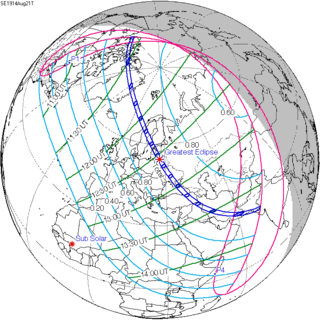| Solar eclipse of August 21, 1914 | |
|---|---|
| Type of eclipse | |
| Nature | Total |
| Gamma | 0.7655 |
| Magnitude | 1.0328 |
| Maximum eclipse | |
| Duration | 134 s (2 min 14 s) |
| Coordinates | 54°30′N 27°06′E / 54.5°N 27.1°E |
| Max. width of band | 170 km (110 mi) |
| Times (UTC) | |
| Greatest eclipse | 12:34:27 |
| References | |
| Saros | 124 (49 of 73) |
| Catalog # (SE5000) | 9314 |
A total solar eclipse occurred at the Moon's descending node of orbit on Friday, August 21, 1914,[1] with a magnitude of 1.0328. A solar eclipse occurs when the Moon passes between Earth and the Sun, thereby totally or partly obscuring the image of the Sun for a viewer on Earth. A total solar eclipse occurs when the Moon's apparent diameter is larger than the Sun's, blocking all direct sunlight, turning day into darkness. Totality occurs in a narrow path across Earth's surface, with the partial solar eclipse visible over a surrounding region thousands of kilometres wide. Occurring about 2.7 days before perigee (on August 24, 1914, at 6:30 UTC), the Moon's apparent diameter was larger.[2]
The totality of this eclipse was visible from northern Canada, Greenland, Norway, Sweden, Russian Empire (the parts now belonging to Åland, Finland, Estonia, Latvia, Lithuania, Belarus, Ukraine and Russia, including cities of Riga, Minsk, Kiev and northeastern part of Vilnius), Ottoman Empire (the parts now belonging to Turkey, northeastern tip of Syria and northern Iraq), Persia and British Raj (the parts now belonging to Pakistan and western tip of India). A partial eclipse was visible for parts of northeast North America, Europe, North Africa, East Africa, and the Middle East. It was the first of four total solar eclipses that would be seen from Sweden during the next 40 years. This total solar eclipse occurred in the same calendar date as 2017, but at the opposite node.
Several astronomers were setting up to observe the eclipse, in part as an attempt to confirm Albert Einstein's theory of general relativity. However, due to the onset of World War I as well as cloud cover, these experiments were unsuccessful.
- ^ "August 21, 1914 Total Solar Eclipse". timeanddate. Retrieved 31 July 2024.
- ^ "Moon Distances for London, United Kingdom, England". timeanddate. Retrieved 31 July 2024.
